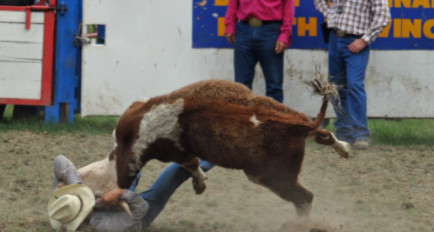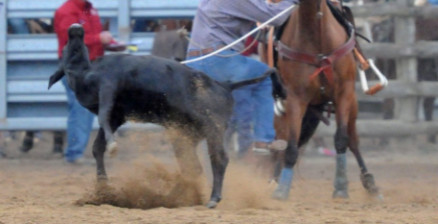There is increasing public concern regarding the welfare of horses and cattle used in rodeos due to the potential risks of injury and distress. The laws relating to rodeos vary widely between states and only provide minimal requirements for the protection of animals.
Rodeos involve several different events including calf rope and tie (also known as calf roping), steer wrestling, bull riding and bronco riding. There are many stresses placed on animals including fear and anxiety as well as risk of injury and death.

The Australian Capital Territory prohibits rodeo events under the ACT Animal Welfare Act 1992. Victoria, and to a lesser extent South Australia, have minimum enforceable standards with a whole section on rodeos contained within the animal welfare regulations. Key requirements include the need to obtain a permit to conduct a rodeo, a veterinarian to be onsite during the event and a minimum body weight of 200 kg for rope and tie events. This effectively disallows young calves from being roped, which is a high-risk event in terms of injury and stress.

Queensland implemented a prohibition on the use of prodders on all horses in August 2020. Victoria also does not permit excessive use of electric prodders on cattle but their use on horses is not specified, whereas in all other states and the Northern Territory rodeo electric prodders can be used on both cattle and horses.
Welfare requirements for rodeo animals are regulated under animal welfare regulations.
In New South Wales and Tasmania, it is mandatory to comply with a specified rodeo welfare code of practice. New South Wales has developed its own code whilst Tasmania requires compliance with standards developed by the now defunct National Consultative Committee on Animal Welfare (NCCAW). Victoria and South Australia have specific sections devoted to legal requirements for rodeos in their animal welfare regulations. In 2019, Victoria introduced some amendments which included mandating that organisers are required to submit an animal welfare plan as part of their permit application to host a rodeo or a rodeo school. In 2021, Queensland introduced a code of practice for rodeos which contains only minimal standards. Western Australia has also developed a rodeo welfare code but although this is proclaimed under animal welfare regulations, it is not mandatory.
The information presented here is not intended to be relied on for legal advice and you should seek advice from the relevant authority and/or a lawyer about your individual circumstances.
Summary of legal requirements for rodeos in each State/Territory
| State/Territory | Legislation specific to rodeos | Comment |
|---|---|---|
| ACT | Animal Welfare Act 1992 Part 2 S18 | Rodeos prohibited |
| New South Wales | Prevention of Cruelty to Animals (General) Regulation 1996 Code of Practice for the Welfare of Animals Used in Rodeo Events 1988 | Must comply with the Code; permits use of electric prodders on cattle & horses |
| Northern Territory | Animal Welfare Regulations 2013 Schedule 1 NCCAW Code of Practice - Standards for the Care and Treatment of Rodeo Livestock 2007 | Permits electric prodder use on horses Code is adopted in the NT Gazette but is not mandatory |
| Queensland | Animal Care and Protection Act 2001, Part 3 Division 1 20 (2) states that a rodeo is not a prohibited event Animal Care and Protection (Code of Practice about Rodeos) Amendment Regulation 2021 | Code of Practice contains minimal requirements |
| South Australia | Animal Welfare Regulations 2012 Part 4 | Some provisions |
| Tasmania | Animal Welfare Act 1993 Part 2 S11A Animal Welfare (General) Regulations 2013 Standards for the Care and Treatment of Rodeo Stock (NCCAW 2006) | Must comply with the NCCAW standards |
| Victoria | Prevention of Cruelty to Animals Act 1986 Division 2 Prevention of Cruelty to Animals Regulations 2019 Part 4 | Reasonable provisions |
| Western Australia | Animal Welfare (General) Regulations 2012 Code of Conduct for Rodeos in Western Australia 2003 | Code is proclaimed in the regulations but is not mandatory |
The following table highlights the inconsistencies in legal requirements in each state/territory for key aspects including electric prodder use, requirement to obtain a rodeo permit and attendance by a veterinarian.
Electric prodders are aversive to animals and should only be used when human or animal safety is jeopardised. It is generally accepted that electric prodders should never be used on horses due to their flighty nature and risk of injury. Prodders are not permitted in other circumstances including transporting horses. There is no justification for prodders to be applied to animals used for the purpose of sport and entertainment. It should be noted that flank straps and spurs (both standard equipment used in bucking bull and horse events) are also aversive to animals but there are no legal requirements in any jurisdiction restricting their use.
Key differences in legal requirements for rodeos in each state/territory
| Qld | NSW | NT | SA | Tas | Vic | WA | |
|---|---|---|---|---|---|---|---|
| Permit to host rodeo required | No | No | No | Yes | No | Yes | No |
| Electric prodder use | Not to perform | ||||||
| No | Yes | Yes | Yes | Yes | No | Yes |
| Yes | Yes rump & shoulder only | Yes | Yes & not anus | Yes | Yes hip & shoulder only | Yes |
| Fireworks permitted | Must not cause fear or distress | Must not use whilst animals on site | Yes | Yes | Must not cause fear or distress | Not during the rodeo | Yes |
| Veterinarian attend | No | No | No | Yes | Yes | Yes | No |
| Veterinarian report | No | No | No | No | Yes | Yes | No |
| Minimum body weight for cattle | 100kg as per Code | 100kg as per Code | Not stated | 200kg* | 100kg as per Code | 200kg* | Not stated |
| Limit on number of times animals are used | Up to 3 times depends on the event | Not stated | Not stated | Up to 3 times | Up to 3 times as per Code | Up to 3 times | Not stated |
| Mothers with unweaned young | Must not use | Can use | Can use | Based on vet advice | Based on vet advice | Must not use | Can use |
* This minimum weight means that calf rope and tie events are prohibited
NB Shading depicts varying levels of protection from strongest (darkest) to weakest (no shading)
Calf rope and tie events are considered to pose the highest risk of injury and distress with ongoing efforts by advocacy groups calling for calf roping to cease. A new published paper highlights the importance of sentience in animals and calves specifically, the purpose of animal protection laws and inconsistencies in regulation of calf roping between Australian jurisdictions [1]. The authors concluded that calf roping causes unnecessary harm which raises concerns regarding the adequacy of legal protection for calves in jurisdictions where calf roping is permitted.
Some effort has been made to develop national welfare standards and guidelines by the rodeo industry. To be effective, wherever rodeos occur, these standards will need to be mandatory, contain appropriate provisions and should be strictly enforced in all states/territories to safeguard against serious welfare risks.
In recent years, legal challenges have been made in Canada and New Zealand on the basis that rodeo contravenes animal welfare legislation, given the recognition of animal sentience and that unnecessary harm is caused to animals. The outcomes from these legal challenges are pending. Reports questioning the legal status of rodeo in these two countries have been published [2, 3].
However, irrespective of any tightening of legislation or implementation of mandatory standards, the RSPCA opposes rodeos due to the potential for significant injury, suffering or distress of animals who are used purely for sport and entertainment.
References
[1] Stonebridge M, Evans D, Kotzmann J (2022) Sentience matters: Analysing the regulation of calf-roping in Australia. Animals, 12.1071
[2] Roy A (2018) Report on the analysis of the data collected during the Montreal and St-Tite rodeos in Quebec (August and September 2017) “Plaintiff’s Report – Part II”.
[2] MacLennan C (2018) The legal status of rodeo in New Zealand. New Zealand Animal Law Association.
